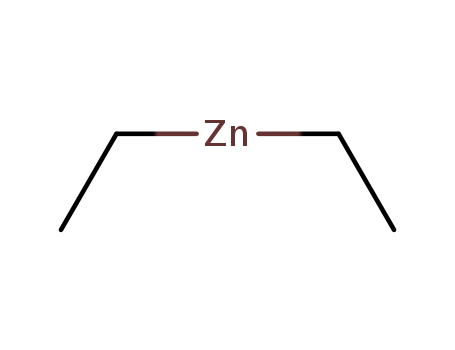10.1021/ol016954r
The study explores the application of [2,2]paracyclophane-based N,O-ligands in the asymmetric addition of alkenylzinc reagents to aldehydes, leading to the formation of chiral allyl alcohols. These compounds are important intermediates in various organic reactions. The research details the development of a method to generate alkenylzinc species through transmetalation using different reagents, which allows for fine-tuning the steric bulk and selectivity of the reaction. The study reports high enantioselectivities, especially for challenging substrates such as α-branched aliphatic aldehydes, and demonstrates the significant impact of the transmetalation agent on catalytic efficiency.
10.1021/jo802371z
The research focuses on the dual stereoselectivity in the dialkylzinc reaction using (-)-α-pinene derived amino alcohol chiral auxiliaries. The study involves the synthesis of two regioisomeric amino alcohols, 3-MAP and 2-MAP, from (+)-nopinone, which is prepared from naturally occurring (-)-α-pinene. These amino alcohols serve as chiral auxiliaries in the addition of diethylzinc to benzaldehyde, yielding secondary alcohols with high enantiomeric excess (ee). The experiments utilize various reactants, including (+)-nopinone, lithium aluminum hydride, and diethylzinc, and employ techniques such as X-ray crystallography, two-dimensional NMR, and NOE correlations for characterization and confirmation of stereochemistry. The research also explores the use of these amino alcohols in the dimethylzinc addition reaction and provides mechanistic insights into the observed dual stereoselectivity. The analyses include chiral gas chromatography to determine the enantiomeric excess and optical rotation to assign the absolute configuration of the products.
10.1016/j.tetasy.2009.12.002
The research focuses on the synthesis of 4,4'-biquinazoline alcohols, which are chiral catalysts used in the enantioselective alkynylation of aldehydes with phenyl acetylene. The study outlines a series of chemical reactions beginning with the condensation of (S)-2-acetoxycarboxylic acid chlorides and 2-aminobenzamide, followed by key steps such as chlorination, nickel(0)-mediated homocoupling, and deprotection to yield the desired chiral 4,4'-biquinazoline alcohols. These catalysts are then combined with Ti(OiPr)4 and utilized in the asymmetric addition of zinc acetylide, generated in situ from phenylacetylene and diethylzinc, to aldehydes. The experiments involved various reactants, including SOCl2, anthranilamide, NaOH, TBDMSCl, POCl3, PhNEt2, NiCl2?6H2O, Zn, DMF, and Bu4NF, among others. The analyses used to characterize the compounds and determine their enantiomeric purities included HPLC, NMR spectroscopy, IR spectroscopy, X-ray diffraction, and specific rotation measurements. The best enantiomeric excess achieved in this study was 75%.
10.1055/s-0037-1612422
The research aims to develop a new approach for the construction of quaternary stereogenic centers bearing nitrogen substituents in an enantioselective manner. The strategy leverages the [1,3]-chirality transfer from a chiral primary alcohol equivalent through an allyl cyanate-to-isocyanate rearrangement. The efficiency of this approach was demonstrated in the eight-step synthesis of the marine natural product (+)-geranyllinaloisocyanide, achieving an overall yield of 43%. Key chemicals used in the process include chiral primary alcohol equivalent, allyl cyanate, isocyanate, and various reagents such as diethylzinc, trichloroacetyl isocyanate, potassium carbonate, trifluoroacetic anhydride, N,N-diisopropylethylamine, lithium triethylborohydride, and cesium fluoride, among others. The study concluded that the allyl cyanate-to-isocyanate rearrangement with enantiomerically enriched α-silyl allyl alcohol is a highly effective method for chirality transfer, showcasing its potential for further applications in the synthesis of nitrogen-containing natural products.
10.1016/j.tetasy.2004.08.009
The study focuses on the synthesis and application of chiral amino thiols as catalysts in the enantioselective addition of diethylzinc to aldehydes, starting from (S)-(-)-valine. A series of new chiral amino thiol and corresponding thioacetate ligands were prepared and utilized in the asymmetric addition, demonstrating excellent enantioselectivity of up to 99% ee with a remarkably low catalyst loading of 0.02mol%. The study highlights the superior performance of these chiral amino thiols compared to traditional amino alcohols, attributing this to the softness of sulfur which exhibits a greater affinity to zinc, in line with the hard soft acid base (HSAB) principle. The research also explores the effect of reaction temperature and solvent on enantioselectivity, finding that less polar solvents without coordinating atoms are more favorable for achieving high ee values. The results underscore the potential of these chiral ligands in asymmetric catalysis, offering a highly efficient and stereoselective method for the addition of diethylzinc to aldehydes.
10.1016/S0040-4039(00)87522-X
The research explores a method for the methylidenation and ethylidenation of allylic thioethers, leading to a 2,3-sigmatropic rearrangement. The study aims to convert allylic phenylthioethers into homoallylic phenylthioethers in a single step using methylene iodide or ethylidene iodide in the presence of diethylzinc, bypassing the need for the Simmons-Smith reaction, which was found to be ineffective in the presence of thioethers. The researchers discovered that the use of diethylzinc and methylene iodide in a homogeneous solution successfully executed the desired transformation, avoiding the formation of an insoluble polymer that occurred with zinc-copper or zinc-silver couples. Key chemicals used in this process include methylene iodide, ethylidene iodide, diethylzinc, and various thioethers such as allylic phenyl sulfide and dimethyl sulfide. The study concluded that the rearrangement could be initiated by ethylidene iodide but not by other diiodoalkanes, and the procedure was effective for the selenium analogue as well, demonstrating the versatility of the method in organic synthesis.
10.1021/jo902172r
The research focuses on the synthesis of (+-)-2-epi-pumiliotoxin C using oxazolone cycloadducts as heterocyclic scaffolds. The study employs an intramolecular Diels-Alder cycloaddition of N-substituted oxazolone triene to directly access the functionalized octahydroquinoline framework. Key chemicals involved in the research include divinyl carbinol, heptadienal, oxazolidine-2,4-dione, and diethylzinc. The synthesis process involves several steps, such as Saucy-type rearrangement, Grignard reaction, Mitsunobu reaction, cyclopropanation, and hydrogenolysis, ultimately leading to the final product (+-)-2-epi-pumiliotoxin C. The research demonstrates the utility of oxazolone IMDA cycloadducts as valuable scaffolds for alkaloid construction and provides a direct incorporation approach to synthesizing complex natural products.



 F,
F, Xn,
Xn, N,
N, C
C


